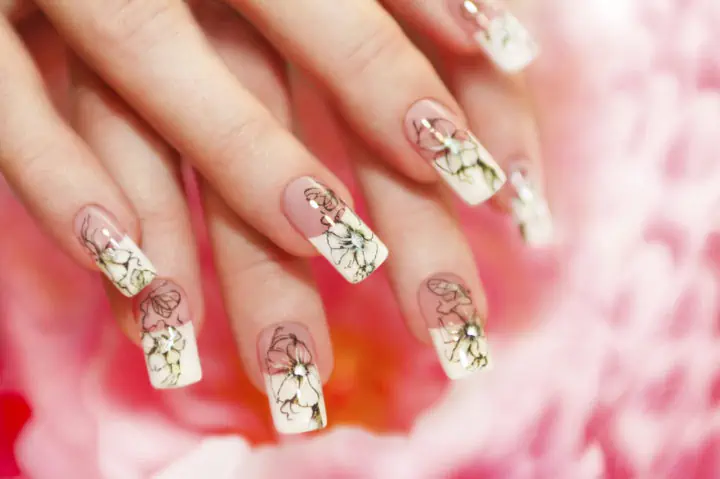Share the post "Soccer Nails (Play With Acrylic Nails in Soccer/Sports)"
While soccer players may not be known for glamorous nails, it’s not uncommon to see some sporting beautiful nail designs.
Nail polish is one thing, but what about acrylic nails?
In short, there’s no rule against wearing acrylic nails. However, if the referee thinks the nails pose a danger, he may ask a player to remove or trim them before a game.
Acrylic nails are allowed, but that’s just the beginning. There are a lot of essential factors for soccer players to consider before getting their nails done.
Here’s what you need to know about acrylic nails in soccer.

Are Fake Nails Allowed in Soccer?
Technically, players can wear long, acrylic, and fake nails in soccer. No law of the game specifically prohibits long or acrylic nails.
However, according to the laws of the game,
“A player must not use equipment or wear anything that is dangerous.“
IFAB Lws of the Game
The simple answer is that players can wear acrylic nails. But when we dive a little deeper, we see that this may be left to referees’ interpretation.
Nails that are very long and sharp may be seen as dangerous and the referee could ask you to remove or trim them before the game.
Ultimately, it’s possible to play soccer with acrylic nails, but the final call will be left to the referee. Nails that are very sharp or long may not be permitted.
Furthermore, players cannot intentionally use nails in ways that go against the game’s rules.
If a player is seen intentionally scratching with their nails, they may face repercussions and be asked to remove the nails.

Why Would Soccer Players Wear Nails?
Soccer players may want to wear gel or acrylic nails for the same reason that they wear jewelry, makeup, or unique hairstyles
They have lives outside of soccer and use nails as a way to express themselves.
Furthermore, it’s quite common to get nails done for an event. Regardless of the reason for getting nails done, trying to keep the style as long as possible is normal.
It’s expensive to get gel or acrylic nails, and even soccer players may want to enjoy the style for a bit.
In reality, it’s not as common to see soccer players wearing acrylic nails as it is to see athletes in some other sports.
- For example, many USWNT players have been spotted playing with painted nails or even gel nails, but rarely with long acrylics.
Take Alex Morgan as an example. She wore bright blue nail polish in the 2019 World Cup, but the nails were still reasonably short.
Can Goalkeepers Wear Long Nails?
In theory, soccer players can wear acrylic nails, but what about goalkeepers? Again, there is no rule restricting goalkeepers from wearing fake nails.
However, wearing long or fake nails as a goalkeeper is a terrible decision.
Goalkeepers should not wear long nails. For one, the nails may not even fit properly in their gloves. Furthermore, you are putting yourself at a huge risk for a bad injury as a goalkeeper with long nails.
Since goalkeepers are intentionally handling the ball, long nails are a safety hazard. It would be very easy for a nail to get badly bent or broken amidst an attempted save.
Experienced goalkeepers recommend keeping nails short and trimmed.
Painting nails and even using gel is fine, but goalkeepers should not wear long or fake nails.
Risks of Wearing Acrylic (or long) Nails in Soccer
You are allowed to wear acrylic nails in soccer as long as they aren’t dangerous to other players.
But the truth is, when it comes down to it, wearing acrylic nails usually isn’t a good idea for soccer players. Here’s why:
- The referee may deem them as dangerous if they are too long or sharp.
- You risk scratching other players or yourself.
- Due to the contact and ball involved, there’s a good risk of damaging a nail or your finger because of it.
- It may prevent you from playing your hardest due to fear of disrupting the nails.
- Longer nails make it more difficult to put on/lace-up soccer shoes and other equipment.
How to Wear Acrylic Nails in Soccer
Despite the risks of wearing acrylic nails in soccer, some players really want to sport them. There are safe ways to wear stylish nails in soccer.
Consider Gel/Dip
The first tip is to consider an alternative to acrylic nails. You do not need fake nails to have beautiful, expressive nails.
Consider using nail polish, gel, or dip instead of acrylic. Gel or dip nails can last up to two weeks and still come in a variety of designs.
Overall, they are a much safer option for athletes competing in a contact sport like soccer.
Keep Nails Reasonably Short
No matter what you decide to do with your nails, length is the main factor. The longer the nails are, the more dangerous they are for soccer.
Opt for shorter nails. Shorter nails are less likely to break, catch on to things, or hurt others.
Plan Acrylics for the Offseason
Some soccer players love long acrylic nails. To keep everyone safe, it’s best to sport those nails in the offseason, or outside of soccer. During the season, you can stick to shorter nail styles.
Rounded Nail Shapes
If you file your nails into a sharp point, there’s a good chance the referee will see them as dangerous. Opt for rounded nail shapes instead of pointed or “coffin” nails.
Wear Gloves
If your nails could be a danger to others in the game, consider wearing gloves. This will prevent the nails from scratching and may make the referee less likely to ask you to remove them.
Conclusion
Playing soccer does not mean you cannot express yourself with your nails. There’s no rule against wearing acrylic nails.
However, some referees may deem very long or sharp nails as a danger, whether they are your natural nail or an acrylic nail.
Overall, it’s best to keep nails shorter and rounder. Most soccer players opt for regular polish or gel over acrylics and save long nail styles for the offseason.
Share the post "Soccer Nails (Play With Acrylic Nails in Soccer/Sports)"
Joel is a seasoned soccer journalist and analyst with many years of experience in the field. Joel specializes in game analysis, player profiles, transfer news, and has a keen eye for the tactical nuances of the game. He played at various levels in the game and coached teams - he is happy to share his insight with you.



